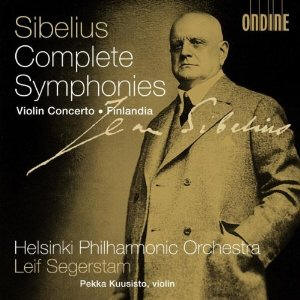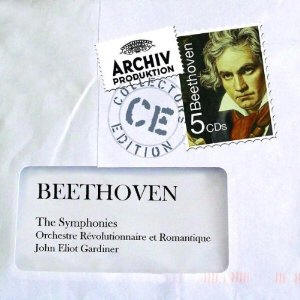|
You are reading the older HTML site
Positive Feedback
ISSUE
58
Notes of an Amateur:
Complete Symphonies of Sibelius and Beethoven
Sibelius, Complete Symphonies. Helsinki Philharmonic Orchestra, Lief Segerstam. Ondine. ODE 107520 (4 cds) Lief Segerstam, who has been playing Sibelius nearly forever, has a distinct and moving way with the music. Coming to him from Vanska, a current favorite, we feel less intensity—because there is less. Segerstam brings a more deliberate approach, feeling with justification that there is not just intensity in this music but also a degree of grandeur that can easily be lost if it is pressed too hard. He prefers to build quietly and steadily toward intensity, establishing a musical foundation from which to take off. Symphony No. 5 is for most of us the touchstone of the Sibelius oeuvre, so I'm going to focus on that one here. I remember being a little disappointed in Segerstam on first hearing his version of the symphony some eight years ago when it was released as a single CD. I kept pleading for him to pick up the pace. Not this time. Now I hear Segerstam's slower pace setting a dramatically larger and grander landscape—Sibelius's directions, after all, are molto moderato. And in fact, what Segerstam is doing is preparing us for the faster pace to follow: when it comes, we can feel everything rise into the air as the music accelerates. But we still have the sense that everything is under control, that every musical moment is part of a larger picture which must always be kept in sight. And then he brings this unforced view to bear on the lilting second movement and, rather than feel as I once did that it wants more energy, I now hear its elegance. The counter melody behind the dance in the foreground now feels more poignant. And as it all flows together into a melodic stream, the whole thing becomes larger than I ever remember its being before. This is not the only way to play this symphony, but it really does work. And it's never heavy, as I remember its being before, it's just patient. Colin Davis goes after something like this in his second series of Sibelius symphony recordings (with the London Symphony) but they come off too refined. He loses the mystic feel of his first series (with the Boston Symphony) and gets nothing memorable in return. Segerstam will have nothing to do with refinement—he is after a more substantial beauty. He begins the third movement faster than he's prepared us to expect, so that the second melody can stride through its nervous energy to greater effect. Segerstam often shows us the power of drama in Sibelius—of artfully managed conflict; but never so powerfully as in the final movement of this symphony. The moods change fast but we can always feel a presiding dramatist, or perhaps, if this is the preferred way to play this music, two—both composer and conductor. Segerstam really does feel as if he's channeling the composer here, which, whether he is or not, is surely the sign of greatness in a conductor. This is a wonderful and truly great Symphony No. 5. Segerstam's approach is consistent through all seven of the symphonies and a very powerful version of the violin concerto (which is part of the album package), such that by the time we're through we truly feel as if the oeuvre holds together as a coherent musical statement: a grander and arguably more significant one than, even as Sibelius fans, we'd been aware of before. The sound is superb, which is no surprise with Ondine, Finland's premier label. The overall sonic perspective is darkness illumined by light glinting off bronze. We feel we are hearing everything—we can see deeply into the dark; but we also sense the presence of things we can't quite see. This is probably too mystical for a record review, but that's what I hear, so you're stuck with it.
Beethoven, The Symphonies. Orchestre Revolutionnaire et Romantique. John Eliot Gardiner. Deutsche Gramophone. DG Archive 477-869359. (5 cd's) Half a dozen or so period instrument orchestras (that I know of) have attempted the near impossible feat of capturing a version of what Beethoven's symphonies may have sounded like in the early nineteenth century, without losing what we have come to feel is essential to their enduring power to move us—the physical weight which modern instruments provide. We have come to believe that this weight represents spiritual and aesthetic substance. Without this weight, especially in Symphonies 1, 3, 5 , 7, and 9, the clarity and instrumental separation period orchestras achieve can sometimes cause Beethoven to sound trivial to us. Of the ones I've heard—Norrington's first version, Hogwood, Brüggen, Van Immerseel, and (lately) Emmanual Krivine—none quite pulls it off, though Krivine and Brüggen come the closest. They all sound appropriately light, lively, crisp, fleet, and full of instrumental flavor on Symphonies 2, 4, 6, and 8, while the odd numbered symphonies sound like music written for a chamber orchestra. But now, seventeen years after they were first recorded (seventeen years after I totally missed the occasion), John Eliot Gardiner, most recently master of the Bach cantatas, arrives in a re-released edition of his 1994 edition of the symphonies. And he's done it! Deutsche Gramophone appears to agree (or possibly wanted to capitalize on the success of the cantata series) and has not only re-released the set but at a huge bargain price of around $20, depending where you shop. Part of this recording's success is the size of the orchestral force. In Symphony No. 5, for example, the orchestra numbers just over sixty musicians. So along with the stunning clarity and brilliance of period instruments, we get a lot of the weight we crave. Six cellos and five double basses 'weigh' a lot. But obviously it takes more than numbers to marry the clarity of the old with the weight of the new (Krivine has 85 musicians!). It takes a recording engineer who understands the challenge and the goal; and Gardiner's engineer captures the venue, providing a wonderful sense of fullness and resonance. And it takes the great musical intelligence of a major conductor, who Gardiner surely is. Time after time we are struck with the effective musical judgments he makes in pace, rhythm, timing, changes in relative loudness. It all feels absolutely right. The sheer energy that bursts from this music is extraordinary. Gardiner's is the first recording of this music I've heard that can finally make a persuasive case that this is how this music must be heard. From the album notes: Period instruments, Gardiner argues, allow us to hear more in these symphonies: the edge is not taken off as it can be with instruments of a later period and sophistication. The instruments also help underwrite the revolutionary nature of Beethoven's genius. Without the 'traffic jams' of sonorities modern instruments can induce, Gardiner can press forward with tempo and dynamics that drive home the sense of Beethoven pushing players and listeners to its limits. This can be a shock to players and to listeners, but is a shock, says Gardiner, which is mitigated by the music's energy and humanity. This has all been said before, but this is the first time it rings true to me. We miss nothing in listening to Gardiner's orchestra and we hear more of everything. But don't we miss something from our first Beethoven symphony experience years ago with say, Van Karajan's mighty Berlin Philharmonic of the late 1950s and early 1960's? I do, or did at first. And it does seem to have something to do with weight. But it's weight, as Gardiner and his album commentator suggest with the image of the traffic jam, that results from modern instruments being so thoroughly blended that they yield a denser texture. It's not weight I miss but density. Because the musical molecules are not so close together in Gardiner's orchestra, there is less density. But now that I've heard what is possible when the density is broken down and clarified, I am finally happier with Gardiner's sound. It is interesting and exciting, not just sonically powerful. There is plenty of weight here but also more than weight. There is Gardiner's great musical intelligence: I can sense musical minds at work, both the composer's and the conductors. See Sibelius and Segerstam above. Okay, time for the final exam, Symphony No. 9, the work that tests the period instrument approach most severely. Doesn't this work in particular depend on the density of a modern orchestra for its grandeur? All previous attempts by period instrument orchestras suggest this is true. But again, with Gardiner what comes through is not the absence of density but the presence of weight—large forces—and Gardiner uses nearly seventy musicians for the work. Gardiner's Ninth has all the grandeur we could ask for but, as with the earlier symphonies, it is not an opaque grandeur but a highly transparent one. We are moved by both weight and clarity. Lots of slashing lightning, not just thunder. I would concede that Gardiner takes a more classical than romantic view of symphony, that there is more beauty than intensity in his Ninth. But weight? No problem. So for me, Gardiner passes the final just fine. But then, I like his Brahms too, which has fewer supporters. Folks just seem to like their Brahms mixed thick. But do try both Norrington's and Gardiner's Brahms someday for fun. I am not a believer that the period instrument movement necessarily takes us closer to the past and that it should be honored for that. What I believe is that it sometimes give us better (and more exciting, more satisfying) performances of early music than modern instruments do. This time! System used for this audition: Audio Note CDT 4 transport; Blue Circle BC501ob LOC dac and FtTH 2 integrated amplifier; JM Reynaud Bliss Silver speakers on JMR Magic Stands; and Crimson cable. Bob Neill, in addition to being an occasional equipment and regular music reviewer for Positive- Feedback Online, is also proprietor of Amherst Audio in Amherst, Massachusetts, which sells equipment from Audio Note, Blue Circle, JM Reynaud, and Crimson Audio.
|


